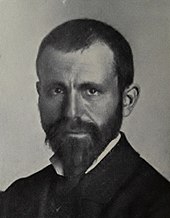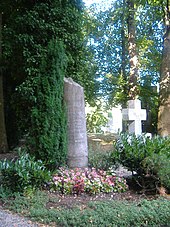George von Hoesslin
Georg Karl Balthasar von Hoeßlin (born March 20, 1851 in Budapest , † February 9, 1923 in Munich ) was a German painter.
Life
Georg von Hösslin came from an Augsburg patrician family . Georg, often also called George, was born in Budapest during a business trip of his parents (Theodor von Hößlin and Emilie née Heinzelmann). He grew up in the USA and was trained there as a businessman after Willem his father's.
In 1871 he went to Munich to become a U. Strahuber student at the Munich School of Applied Arts and the Academy of Fine Arts . In essence, he continued to educate himself . Rome and Venice were his favorite places to study.
In 1884 he took up his permanent residence in Munich. Here he was inspired by Wilhelm von Lindenschmit the Younger . His artistic activity, which he himself divides into three periods, he initiated in 1876 with the painting "Abandoned". In addition to history and allegories, he painted naturalistic landscapes , portraits . Much of his work went into private English and American ownership.
He was a member of the General German Art Cooperative .
Two children arose from his marriage to Elisabeth Merck: son Heinrich Balthasar , who was married to Emma von Hoesslin , and daughter Margarethe, who married Max Planck in 1911 . He was buried in the city of Augsburg's grave of honor in the Westfriedhof .
Works
- 1875: Abandoned , Roman landscape, exhibited in the arts and crafts exhibition in the Munich Glass Palace
- 1876: Cogoletto , also a Roman landscape
- 1879: 1517 , (age of the Reformation) the first character image of the American Ambassador Andrew Dickson White bought
- 1884: Adagio consolante
- 1884: Organ fantasy
- Main work: Laocoon
Drawing in: Die Gartenlaube , 1985
Other works, often reproduced by Franz Hanfstaengl and distributed worldwide through postcard printing:
- Pandora , from The Illustrated London News , Sept. 27, 1890.- 404
- Fame Crowning Art , from The Illustrated London News , Nov. 8, 1890, - 588:
- Villa Spinola , u. a. published in Der Türmer Heft 11, August 1907, double page 600
- A woman's magic , u. a. published in Der Türmer Heft 11, August 1907, p. 617
- The young Pan
- A castle in the air
- Vision of a world church
- Erring soul
- Mary, mother of love
- Mariae Divinatio
- The rocks of Medusa
- Villa Pagana
- Fascination
- The wisdom
- Pan
literature
- Intellectual Germany at the end of the 19th century. Leipzig and Berlin 1898, p. 314.
- Artur Dobsty: George von Hoeßlin . In: The tower keeper . May 1907, pp. 279-286 ( Textarchiv - Internet Archive ).
- George von Hoesslin. In: The Art of Our Time. 21st year, delivery 7 April 1910, Hanfstaengl, Munich 1910.
- Hoesslin, George von . In: Hans Vollmer (Hrsg.): General lexicon of fine artists from antiquity to the present . Founded by Ulrich Thieme and Felix Becker . tape 17 : Heubel – Hubard . EA Seemann, Leipzig 1924, p. 223-224 .
- Heidi C. Ebertshäuser: Painting in the 19th Century. Munich School. Munich 1979, p. 209.
- Sonja von Baranow: Munich painter in the 19th century (= Bruckmann's Lexicon of Munich Art ). Volume 2, pp. 203–204 (inter alia with illus. Of the signature).
- Hartmut von Hößlin: Hösslin. Data from 5 centuries. Wißner, Augsburg 1997, ISBN 3-89639-087-2 , pp. 40-43.
Web links
Individual evidence
- ↑ Arthur Dobsty: The Tower Keeper . 1907, pp. 279-286 ( Textarchiv - Internet Archive ).
- ^ Entry in the matriculation database: Georg Hoesslin .
| personal data | |
|---|---|
| SURNAME | Hoesslin, George von |
| ALTERNATIVE NAMES | Hoeßlin, Georg Karl Balthasar von |
| BRIEF DESCRIPTION | German painter |
| DATE OF BIRTH | March 20, 1851 |
| PLACE OF BIRTH | Budapest |
| DATE OF DEATH | February 9, 1923 |
| Place of death | Munich |






